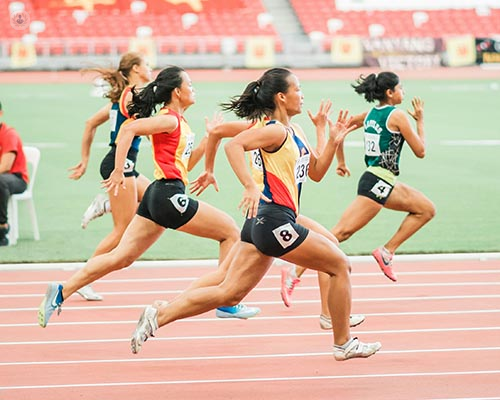Sports injuries: a comprehensive guide
Escrito por:Injuries sustained during sports can pose a frustrating setback for athletes of all levels. Regardless of whether you're a seasoned pro or a weekend enthusiast, the potential for injury is an inherent aspect of any physical activity.
Distinguished consultant orthopaedic surgeon Mr Stephen Bendall examines the common types of sports injuries, their causes, symptoms, and treatment options to help you navigate through potential setbacks on your journey to recovery and continued fitness.

Types of sports injuries
Sports injuries encompass a wide range of conditions that affect muscles, tendons, ligaments, bones, and joints. Some of the most common types include:
Strains and sprains: Strains involve stretched or torn muscles or tendons, while sprains occur when ligaments are stretched or torn. These injuries often result from overexertion, sudden movements, or improper technique.
Fractures: Fractures refer to broken bones, which can occur due to direct impact, repetitive stress, or falls during sports activities.
Tendonitis: Tendonitis involves inflammation or irritation of the tendons, commonly caused by overuse or repetitive motions.
Dislocations: Dislocations occur when the bones in a joint are forced out of their normal position, often due to a sudden impact or twisting motion.
Causes and risk factors
Sports injuries can be caused by various factors, including:
- Overtraining or inadequate rest periods.
- Poor technique or improper equipment usage.
- Lack of warm-up or stretching exercises.
- Environmental factors such as uneven playing surfaces or extreme weather conditions.
- Certain risk factors, such as age, previous injuries, and underlying medical conditions, can also predispose individuals to sports injuries.
Recognising Symptoms
It's essential to recognise the signs and symptoms of sports injuries, which may include:
- Pain, swelling, or tenderness in the affected area.
- Limited range of motion or difficulty bearing weight.
- Bruising or discolouration.
- Popping or cracking sounds at the time of injury.
Seeking prompt medical attention is crucial to prevent further damage and promote effective healing.
Treatment and recovery
The treatment approach for sports injuries may vary depending on the type and severity of the condition. Common strategies include:
- Rest, ice, compression, and elevation (RICE) to reduce pain and inflammation.
- Physiotherapy exercises to strengthen muscles and improve flexibility.
- Pain relief medication or anti-inflammatory drugs.
- Immobilisation devices such as braces or splints for fractures or dislocation.
- Surgery in severe cases requiring repair or reconstruction of damaged tissues.
- Recovery from a sports injury typically involves a gradual return to activity, guided by healthcare professionals to prevent reinjury and promote long-term recovery.
Sports injuries can be a setback, but with the right approach to treatment and rehabilitation, most individuals can overcome them and return to their favourite activities stronger and more resilient than before. By understanding the causes, symptoms, and treatment options for sports injuries, you can take proactive steps to protect yourself and enjoy the benefits of a healthy, active lifestyle.
If you are suffering from a sports injury and would like to book a consultation with Mr Bendall, simply visit his Top Doctors profile today.


